Report on Pitching and Negotiation Skills for Tesco: Strategies
VerifiedAdded on 2020/10/22
|15
|4723
|420
Report
AI Summary
This report examines the crucial aspects of pitching and negotiation skills, using Tesco as a case study. It begins by defining negotiation, its occurrences, and key stakeholders, followed by an evaluation of the steps and information required for negotiating and generating deals. The report then delves into the Request for Proposal (RFP) process, including relevant documentation types, and the management and monitoring of contractual processes. A key section focuses on developing a pitch that leverages key principles to achieve a sustainable competitive edge. The report also assesses potential pitch outcomes and determines how an organization can fulfill post-pitch obligations, highlighting potential issues. Overall, the report provides a comprehensive analysis of negotiation and pitching strategies, offering practical insights applicable to the business environment, with a specific focus on the practices of Tesco.

Pitching and
Negotiation Skills
Negotiation Skills
Paraphrase This Document
Need a fresh take? Get an instant paraphrase of this document with our AI Paraphraser
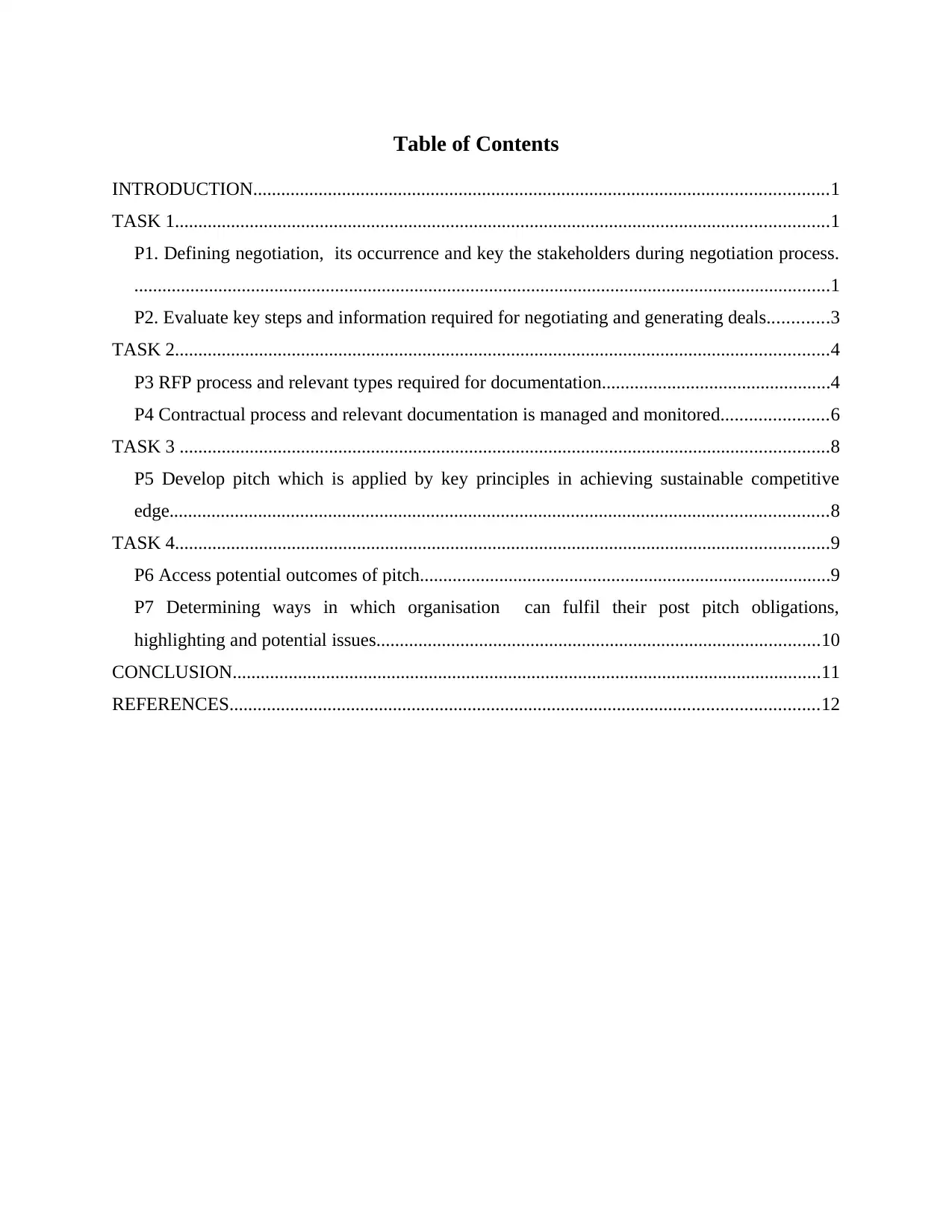
Table of Contents
INTRODUCTION...........................................................................................................................1
TASK 1............................................................................................................................................1
P1. Defining negotiation, its occurrence and key the stakeholders during negotiation process.
.....................................................................................................................................................1
P2. Evaluate key steps and information required for negotiating and generating deals.............3
TASK 2............................................................................................................................................4
P3 RFP process and relevant types required for documentation.................................................4
P4 Contractual process and relevant documentation is managed and monitored.......................6
TASK 3 ...........................................................................................................................................8
P5 Develop pitch which is applied by key principles in achieving sustainable competitive
edge.............................................................................................................................................8
TASK 4............................................................................................................................................9
P6 Access potential outcomes of pitch........................................................................................9
P7 Determining ways in which organisation can fulfil their post pitch obligations,
highlighting and potential issues...............................................................................................10
CONCLUSION..............................................................................................................................11
REFERENCES..............................................................................................................................12
INTRODUCTION...........................................................................................................................1
TASK 1............................................................................................................................................1
P1. Defining negotiation, its occurrence and key the stakeholders during negotiation process.
.....................................................................................................................................................1
P2. Evaluate key steps and information required for negotiating and generating deals.............3
TASK 2............................................................................................................................................4
P3 RFP process and relevant types required for documentation.................................................4
P4 Contractual process and relevant documentation is managed and monitored.......................6
TASK 3 ...........................................................................................................................................8
P5 Develop pitch which is applied by key principles in achieving sustainable competitive
edge.............................................................................................................................................8
TASK 4............................................................................................................................................9
P6 Access potential outcomes of pitch........................................................................................9
P7 Determining ways in which organisation can fulfil their post pitch obligations,
highlighting and potential issues...............................................................................................10
CONCLUSION..............................................................................................................................11
REFERENCES..............................................................................................................................12
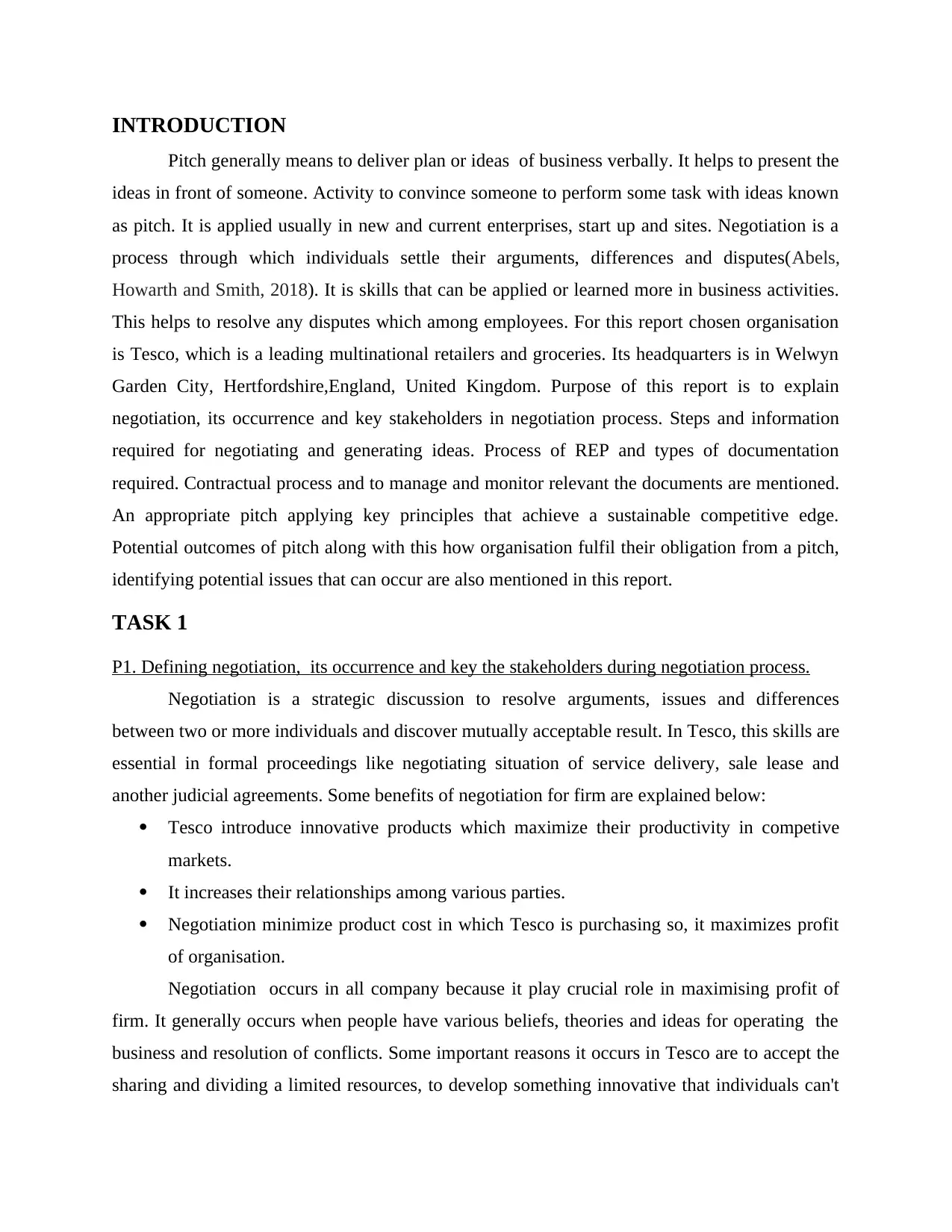
INTRODUCTION
Pitch generally means to deliver plan or ideas of business verbally. It helps to present the
ideas in front of someone. Activity to convince someone to perform some task with ideas known
as pitch. It is applied usually in new and current enterprises, start up and sites. Negotiation is a
process through which individuals settle their arguments, differences and disputes(Abels,
Howarth and Smith, 2018). It is skills that can be applied or learned more in business activities.
This helps to resolve any disputes which among employees. For this report chosen organisation
is Tesco, which is a leading multinational retailers and groceries. Its headquarters is in Welwyn
Garden City, Hertfordshire,England, United Kingdom. Purpose of this report is to explain
negotiation, its occurrence and key stakeholders in negotiation process. Steps and information
required for negotiating and generating ideas. Process of REP and types of documentation
required. Contractual process and to manage and monitor relevant the documents are mentioned.
An appropriate pitch applying key principles that achieve a sustainable competitive edge.
Potential outcomes of pitch along with this how organisation fulfil their obligation from a pitch,
identifying potential issues that can occur are also mentioned in this report.
TASK 1
P1. Defining negotiation, its occurrence and key the stakeholders during negotiation process.
Negotiation is a strategic discussion to resolve arguments, issues and differences
between two or more individuals and discover mutually acceptable result. In Tesco, this skills are
essential in formal proceedings like negotiating situation of service delivery, sale lease and
another judicial agreements. Some benefits of negotiation for firm are explained below:
Tesco introduce innovative products which maximize their productivity in competive
markets.
It increases their relationships among various parties.
Negotiation minimize product cost in which Tesco is purchasing so, it maximizes profit
of organisation.
Negotiation occurs in all company because it play crucial role in maximising profit of
firm. It generally occurs when people have various beliefs, theories and ideas for operating the
business and resolution of conflicts. Some important reasons it occurs in Tesco are to accept the
sharing and dividing a limited resources, to develop something innovative that individuals can't
Pitch generally means to deliver plan or ideas of business verbally. It helps to present the
ideas in front of someone. Activity to convince someone to perform some task with ideas known
as pitch. It is applied usually in new and current enterprises, start up and sites. Negotiation is a
process through which individuals settle their arguments, differences and disputes(Abels,
Howarth and Smith, 2018). It is skills that can be applied or learned more in business activities.
This helps to resolve any disputes which among employees. For this report chosen organisation
is Tesco, which is a leading multinational retailers and groceries. Its headquarters is in Welwyn
Garden City, Hertfordshire,England, United Kingdom. Purpose of this report is to explain
negotiation, its occurrence and key stakeholders in negotiation process. Steps and information
required for negotiating and generating ideas. Process of REP and types of documentation
required. Contractual process and to manage and monitor relevant the documents are mentioned.
An appropriate pitch applying key principles that achieve a sustainable competitive edge.
Potential outcomes of pitch along with this how organisation fulfil their obligation from a pitch,
identifying potential issues that can occur are also mentioned in this report.
TASK 1
P1. Defining negotiation, its occurrence and key the stakeholders during negotiation process.
Negotiation is a strategic discussion to resolve arguments, issues and differences
between two or more individuals and discover mutually acceptable result. In Tesco, this skills are
essential in formal proceedings like negotiating situation of service delivery, sale lease and
another judicial agreements. Some benefits of negotiation for firm are explained below:
Tesco introduce innovative products which maximize their productivity in competive
markets.
It increases their relationships among various parties.
Negotiation minimize product cost in which Tesco is purchasing so, it maximizes profit
of organisation.
Negotiation occurs in all company because it play crucial role in maximising profit of
firm. It generally occurs when people have various beliefs, theories and ideas for operating the
business and resolution of conflicts. Some important reasons it occurs in Tesco are to accept the
sharing and dividing a limited resources, to develop something innovative that individuals can't
⊘ This is a preview!⊘
Do you want full access?
Subscribe today to unlock all pages.

Trusted by 1+ million students worldwide
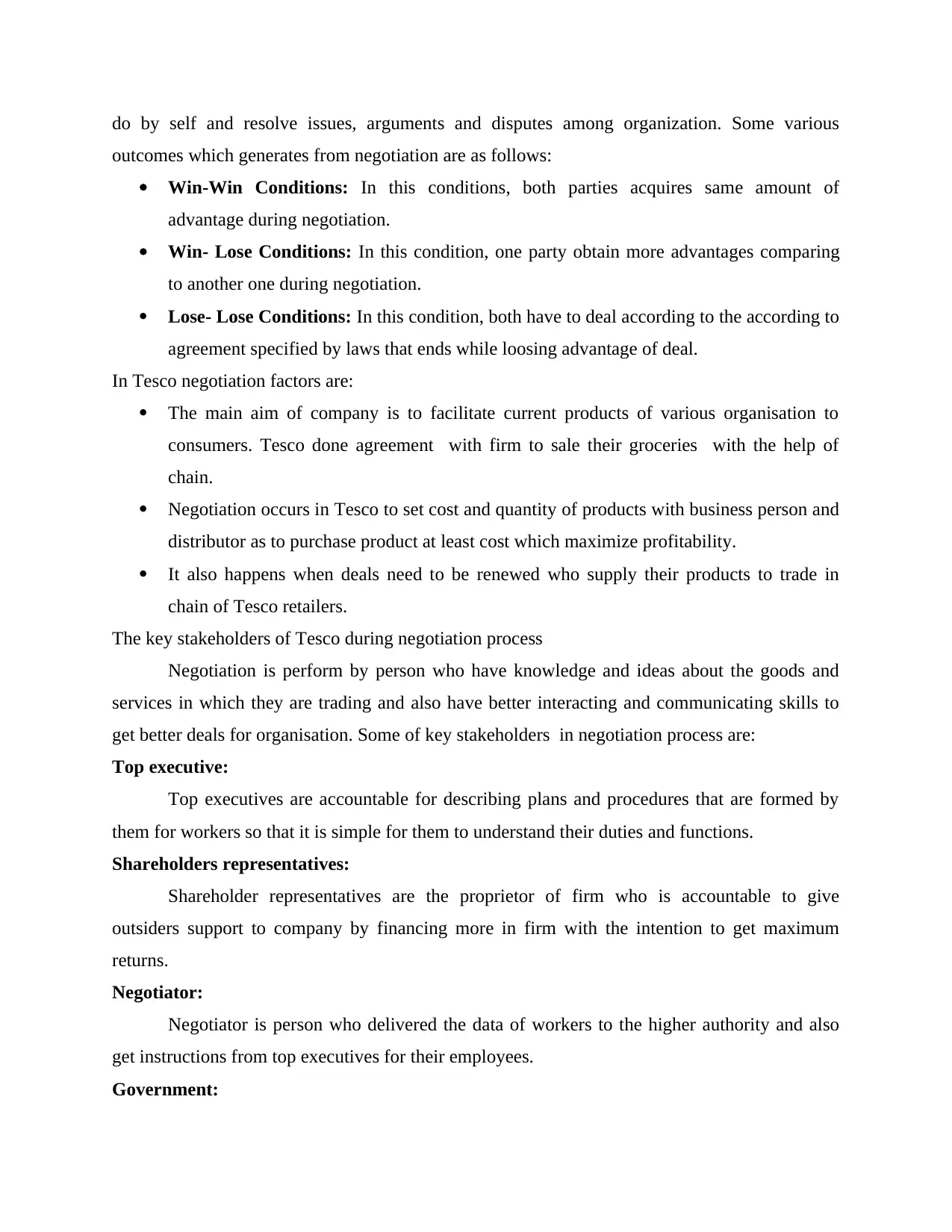
do by self and resolve issues, arguments and disputes among organization. Some various
outcomes which generates from negotiation are as follows:
Win-Win Conditions: In this conditions, both parties acquires same amount of
advantage during negotiation.
Win- Lose Conditions: In this condition, one party obtain more advantages comparing
to another one during negotiation.
Lose- Lose Conditions: In this condition, both have to deal according to the according to
agreement specified by laws that ends while loosing advantage of deal.
In Tesco negotiation factors are:
The main aim of company is to facilitate current products of various organisation to
consumers. Tesco done agreement with firm to sale their groceries with the help of
chain.
Negotiation occurs in Tesco to set cost and quantity of products with business person and
distributor as to purchase product at least cost which maximize profitability.
It also happens when deals need to be renewed who supply their products to trade in
chain of Tesco retailers.
The key stakeholders of Tesco during negotiation process
Negotiation is perform by person who have knowledge and ideas about the goods and
services in which they are trading and also have better interacting and communicating skills to
get better deals for organisation. Some of key stakeholders in negotiation process are:
Top executive:
Top executives are accountable for describing plans and procedures that are formed by
them for workers so that it is simple for them to understand their duties and functions.
Shareholders representatives:
Shareholder representatives are the proprietor of firm who is accountable to give
outsiders support to company by financing more in firm with the intention to get maximum
returns.
Negotiator:
Negotiator is person who delivered the data of workers to the higher authority and also
get instructions from top executives for their employees.
Government:
outcomes which generates from negotiation are as follows:
Win-Win Conditions: In this conditions, both parties acquires same amount of
advantage during negotiation.
Win- Lose Conditions: In this condition, one party obtain more advantages comparing
to another one during negotiation.
Lose- Lose Conditions: In this condition, both have to deal according to the according to
agreement specified by laws that ends while loosing advantage of deal.
In Tesco negotiation factors are:
The main aim of company is to facilitate current products of various organisation to
consumers. Tesco done agreement with firm to sale their groceries with the help of
chain.
Negotiation occurs in Tesco to set cost and quantity of products with business person and
distributor as to purchase product at least cost which maximize profitability.
It also happens when deals need to be renewed who supply their products to trade in
chain of Tesco retailers.
The key stakeholders of Tesco during negotiation process
Negotiation is perform by person who have knowledge and ideas about the goods and
services in which they are trading and also have better interacting and communicating skills to
get better deals for organisation. Some of key stakeholders in negotiation process are:
Top executive:
Top executives are accountable for describing plans and procedures that are formed by
them for workers so that it is simple for them to understand their duties and functions.
Shareholders representatives:
Shareholder representatives are the proprietor of firm who is accountable to give
outsiders support to company by financing more in firm with the intention to get maximum
returns.
Negotiator:
Negotiator is person who delivered the data of workers to the higher authority and also
get instructions from top executives for their employees.
Government:
Paraphrase This Document
Need a fresh take? Get an instant paraphrase of this document with our AI Paraphraser
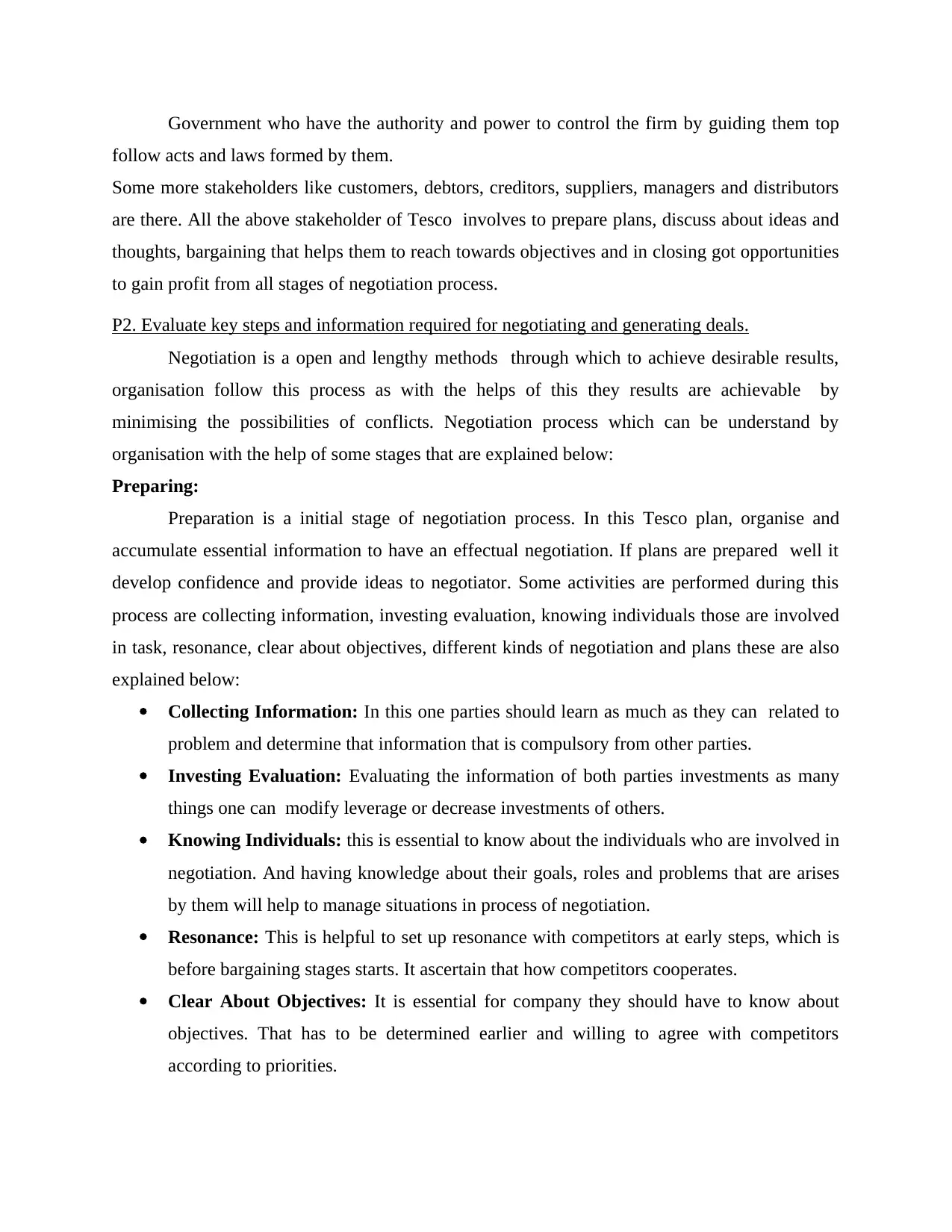
Government who have the authority and power to control the firm by guiding them top
follow acts and laws formed by them.
Some more stakeholders like customers, debtors, creditors, suppliers, managers and distributors
are there. All the above stakeholder of Tesco involves to prepare plans, discuss about ideas and
thoughts, bargaining that helps them to reach towards objectives and in closing got opportunities
to gain profit from all stages of negotiation process.
P2. Evaluate key steps and information required for negotiating and generating deals.
Negotiation is a open and lengthy methods through which to achieve desirable results,
organisation follow this process as with the helps of this they results are achievable by
minimising the possibilities of conflicts. Negotiation process which can be understand by
organisation with the help of some stages that are explained below:
Preparing:
Preparation is a initial stage of negotiation process. In this Tesco plan, organise and
accumulate essential information to have an effectual negotiation. If plans are prepared well it
develop confidence and provide ideas to negotiator. Some activities are performed during this
process are collecting information, investing evaluation, knowing individuals those are involved
in task, resonance, clear about objectives, different kinds of negotiation and plans these are also
explained below:
Collecting Information: In this one parties should learn as much as they can related to
problem and determine that information that is compulsory from other parties.
Investing Evaluation: Evaluating the information of both parties investments as many
things one can modify leverage or decrease investments of others.
Knowing Individuals: this is essential to know about the individuals who are involved in
negotiation. And having knowledge about their goals, roles and problems that are arises
by them will help to manage situations in process of negotiation.
Resonance: This is helpful to set up resonance with competitors at early steps, which is
before bargaining stages starts. It ascertain that how competitors cooperates.
Clear About Objectives: It is essential for company they should have to know about
objectives. That has to be determined earlier and willing to agree with competitors
according to priorities.
follow acts and laws formed by them.
Some more stakeholders like customers, debtors, creditors, suppliers, managers and distributors
are there. All the above stakeholder of Tesco involves to prepare plans, discuss about ideas and
thoughts, bargaining that helps them to reach towards objectives and in closing got opportunities
to gain profit from all stages of negotiation process.
P2. Evaluate key steps and information required for negotiating and generating deals.
Negotiation is a open and lengthy methods through which to achieve desirable results,
organisation follow this process as with the helps of this they results are achievable by
minimising the possibilities of conflicts. Negotiation process which can be understand by
organisation with the help of some stages that are explained below:
Preparing:
Preparation is a initial stage of negotiation process. In this Tesco plan, organise and
accumulate essential information to have an effectual negotiation. If plans are prepared well it
develop confidence and provide ideas to negotiator. Some activities are performed during this
process are collecting information, investing evaluation, knowing individuals those are involved
in task, resonance, clear about objectives, different kinds of negotiation and plans these are also
explained below:
Collecting Information: In this one parties should learn as much as they can related to
problem and determine that information that is compulsory from other parties.
Investing Evaluation: Evaluating the information of both parties investments as many
things one can modify leverage or decrease investments of others.
Knowing Individuals: this is essential to know about the individuals who are involved in
negotiation. And having knowledge about their goals, roles and problems that are arises
by them will help to manage situations in process of negotiation.
Resonance: This is helpful to set up resonance with competitors at early steps, which is
before bargaining stages starts. It ascertain that how competitors cooperates.
Clear About Objectives: It is essential for company they should have to know about
objectives. That has to be determined earlier and willing to agree with competitors
according to priorities.
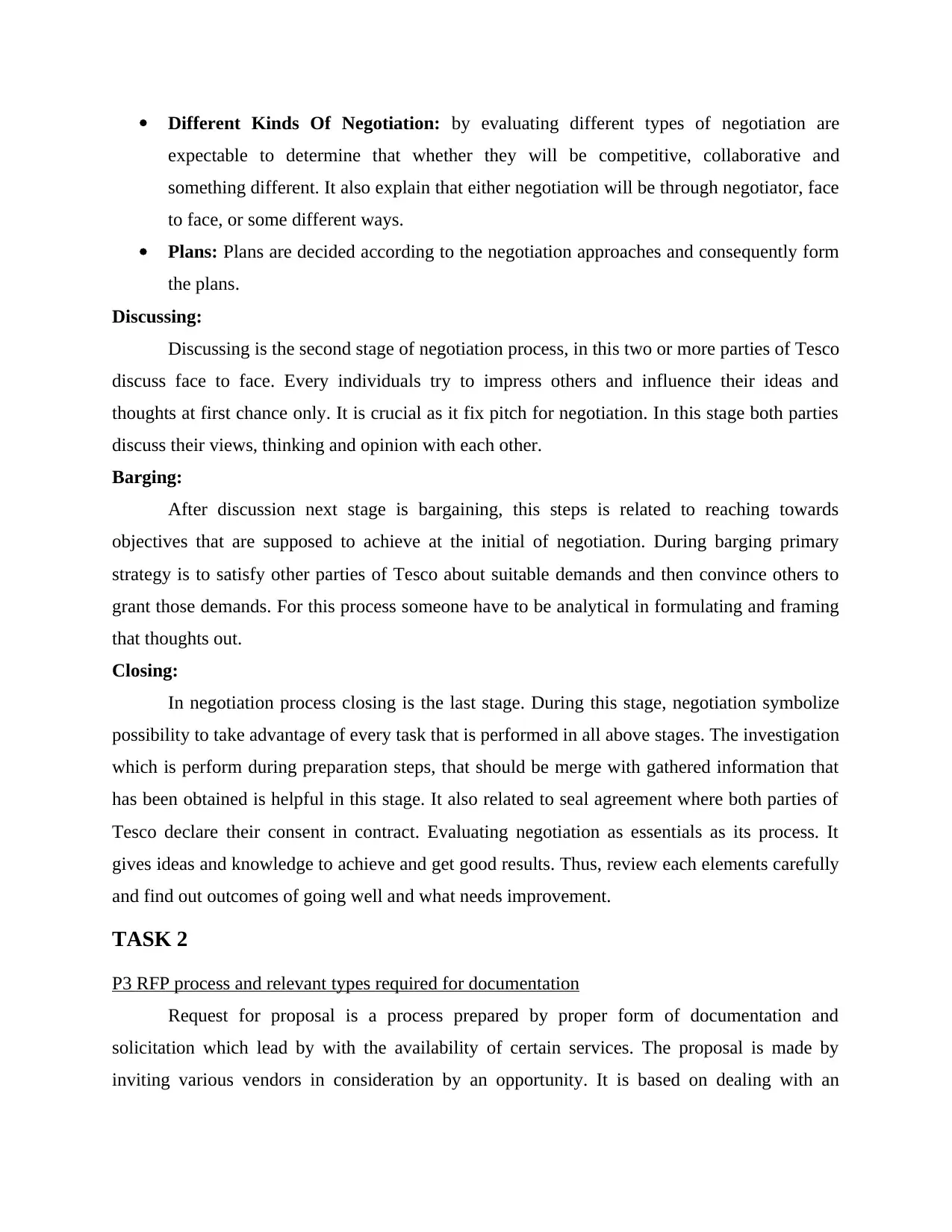
Different Kinds Of Negotiation: by evaluating different types of negotiation are
expectable to determine that whether they will be competitive, collaborative and
something different. It also explain that either negotiation will be through negotiator, face
to face, or some different ways.
Plans: Plans are decided according to the negotiation approaches and consequently form
the plans.
Discussing:
Discussing is the second stage of negotiation process, in this two or more parties of Tesco
discuss face to face. Every individuals try to impress others and influence their ideas and
thoughts at first chance only. It is crucial as it fix pitch for negotiation. In this stage both parties
discuss their views, thinking and opinion with each other.
Barging:
After discussion next stage is bargaining, this steps is related to reaching towards
objectives that are supposed to achieve at the initial of negotiation. During barging primary
strategy is to satisfy other parties of Tesco about suitable demands and then convince others to
grant those demands. For this process someone have to be analytical in formulating and framing
that thoughts out.
Closing:
In negotiation process closing is the last stage. During this stage, negotiation symbolize
possibility to take advantage of every task that is performed in all above stages. The investigation
which is perform during preparation steps, that should be merge with gathered information that
has been obtained is helpful in this stage. It also related to seal agreement where both parties of
Tesco declare their consent in contract. Evaluating negotiation as essentials as its process. It
gives ideas and knowledge to achieve and get good results. Thus, review each elements carefully
and find out outcomes of going well and what needs improvement.
TASK 2
P3 RFP process and relevant types required for documentation
Request for proposal is a process prepared by proper form of documentation and
solicitation which lead by with the availability of certain services. The proposal is made by
inviting various vendors in consideration by an opportunity. It is based on dealing with an
expectable to determine that whether they will be competitive, collaborative and
something different. It also explain that either negotiation will be through negotiator, face
to face, or some different ways.
Plans: Plans are decided according to the negotiation approaches and consequently form
the plans.
Discussing:
Discussing is the second stage of negotiation process, in this two or more parties of Tesco
discuss face to face. Every individuals try to impress others and influence their ideas and
thoughts at first chance only. It is crucial as it fix pitch for negotiation. In this stage both parties
discuss their views, thinking and opinion with each other.
Barging:
After discussion next stage is bargaining, this steps is related to reaching towards
objectives that are supposed to achieve at the initial of negotiation. During barging primary
strategy is to satisfy other parties of Tesco about suitable demands and then convince others to
grant those demands. For this process someone have to be analytical in formulating and framing
that thoughts out.
Closing:
In negotiation process closing is the last stage. During this stage, negotiation symbolize
possibility to take advantage of every task that is performed in all above stages. The investigation
which is perform during preparation steps, that should be merge with gathered information that
has been obtained is helpful in this stage. It also related to seal agreement where both parties of
Tesco declare their consent in contract. Evaluating negotiation as essentials as its process. It
gives ideas and knowledge to achieve and get good results. Thus, review each elements carefully
and find out outcomes of going well and what needs improvement.
TASK 2
P3 RFP process and relevant types required for documentation
Request for proposal is a process prepared by proper form of documentation and
solicitation which lead by with the availability of certain services. The proposal is made by
inviting various vendors in consideration by an opportunity. It is based on dealing with an
⊘ This is a preview!⊘
Do you want full access?
Subscribe today to unlock all pages.

Trusted by 1+ million students worldwide
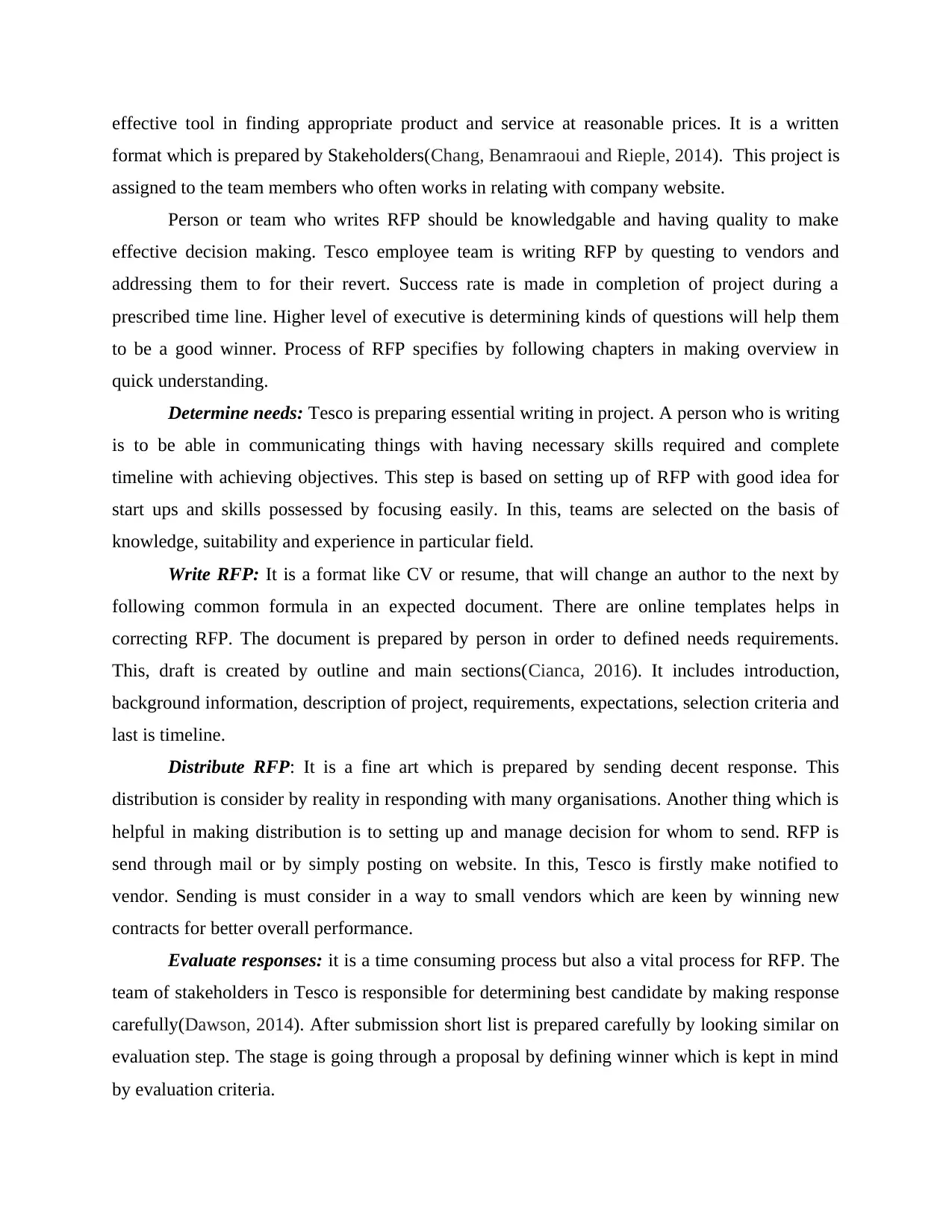
effective tool in finding appropriate product and service at reasonable prices. It is a written
format which is prepared by Stakeholders(Chang, Benamraoui and Rieple, 2014). This project is
assigned to the team members who often works in relating with company website.
Person or team who writes RFP should be knowledgable and having quality to make
effective decision making. Tesco employee team is writing RFP by questing to vendors and
addressing them to for their revert. Success rate is made in completion of project during a
prescribed time line. Higher level of executive is determining kinds of questions will help them
to be a good winner. Process of RFP specifies by following chapters in making overview in
quick understanding.
Determine needs: Tesco is preparing essential writing in project. A person who is writing
is to be able in communicating things with having necessary skills required and complete
timeline with achieving objectives. This step is based on setting up of RFP with good idea for
start ups and skills possessed by focusing easily. In this, teams are selected on the basis of
knowledge, suitability and experience in particular field.
Write RFP: It is a format like CV or resume, that will change an author to the next by
following common formula in an expected document. There are online templates helps in
correcting RFP. The document is prepared by person in order to defined needs requirements.
This, draft is created by outline and main sections(Cianca, 2016). It includes introduction,
background information, description of project, requirements, expectations, selection criteria and
last is timeline.
Distribute RFP: It is a fine art which is prepared by sending decent response. This
distribution is consider by reality in responding with many organisations. Another thing which is
helpful in making distribution is to setting up and manage decision for whom to send. RFP is
send through mail or by simply posting on website. In this, Tesco is firstly make notified to
vendor. Sending is must consider in a way to small vendors which are keen by winning new
contracts for better overall performance.
Evaluate responses: it is a time consuming process but also a vital process for RFP. The
team of stakeholders in Tesco is responsible for determining best candidate by making response
carefully(Dawson, 2014). After submission short list is prepared carefully by looking similar on
evaluation step. The stage is going through a proposal by defining winner which is kept in mind
by evaluation criteria.
format which is prepared by Stakeholders(Chang, Benamraoui and Rieple, 2014). This project is
assigned to the team members who often works in relating with company website.
Person or team who writes RFP should be knowledgable and having quality to make
effective decision making. Tesco employee team is writing RFP by questing to vendors and
addressing them to for their revert. Success rate is made in completion of project during a
prescribed time line. Higher level of executive is determining kinds of questions will help them
to be a good winner. Process of RFP specifies by following chapters in making overview in
quick understanding.
Determine needs: Tesco is preparing essential writing in project. A person who is writing
is to be able in communicating things with having necessary skills required and complete
timeline with achieving objectives. This step is based on setting up of RFP with good idea for
start ups and skills possessed by focusing easily. In this, teams are selected on the basis of
knowledge, suitability and experience in particular field.
Write RFP: It is a format like CV or resume, that will change an author to the next by
following common formula in an expected document. There are online templates helps in
correcting RFP. The document is prepared by person in order to defined needs requirements.
This, draft is created by outline and main sections(Cianca, 2016). It includes introduction,
background information, description of project, requirements, expectations, selection criteria and
last is timeline.
Distribute RFP: It is a fine art which is prepared by sending decent response. This
distribution is consider by reality in responding with many organisations. Another thing which is
helpful in making distribution is to setting up and manage decision for whom to send. RFP is
send through mail or by simply posting on website. In this, Tesco is firstly make notified to
vendor. Sending is must consider in a way to small vendors which are keen by winning new
contracts for better overall performance.
Evaluate responses: it is a time consuming process but also a vital process for RFP. The
team of stakeholders in Tesco is responsible for determining best candidate by making response
carefully(Dawson, 2014). After submission short list is prepared carefully by looking similar on
evaluation step. The stage is going through a proposal by defining winner which is kept in mind
by evaluation criteria.
Paraphrase This Document
Need a fresh take? Get an instant paraphrase of this document with our AI Paraphraser
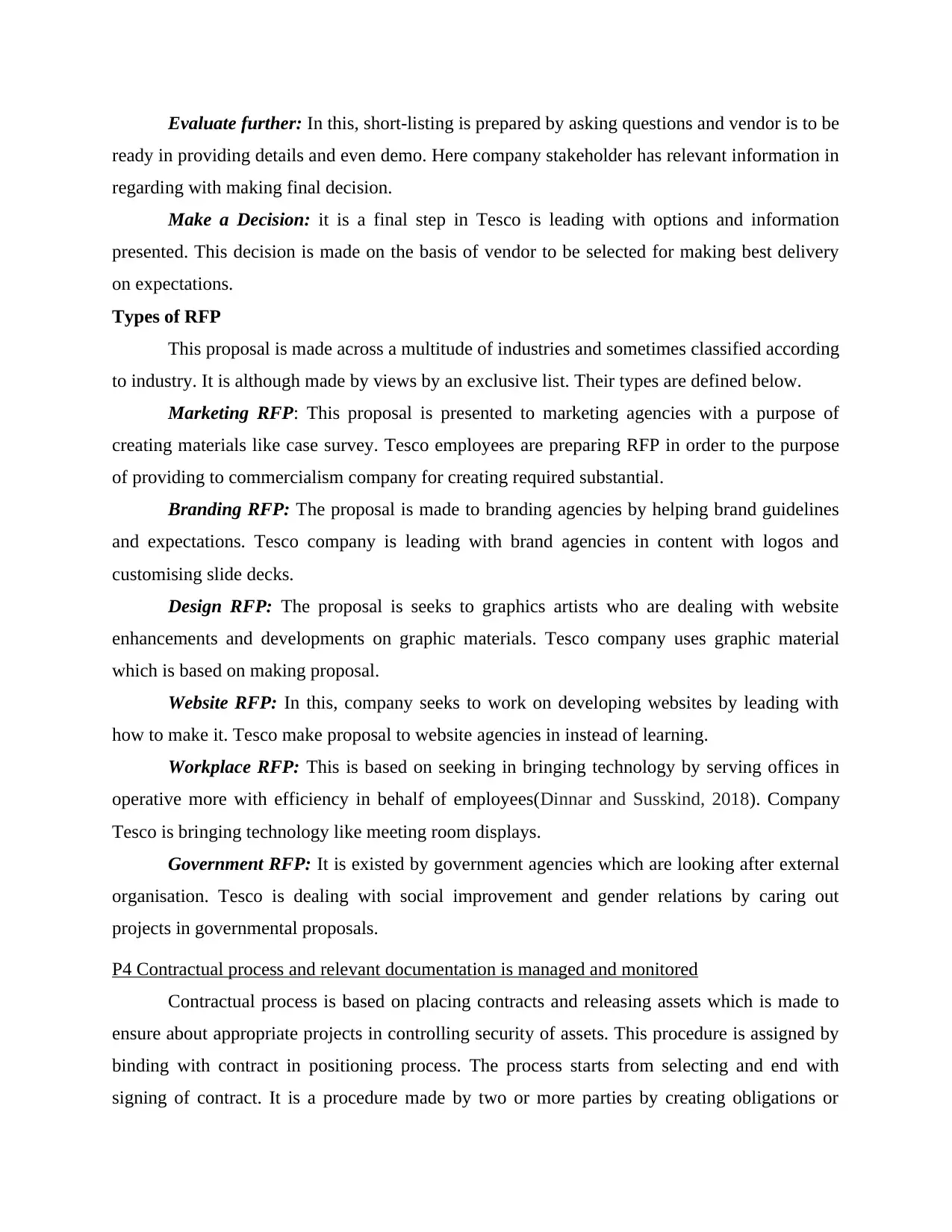
Evaluate further: In this, short-listing is prepared by asking questions and vendor is to be
ready in providing details and even demo. Here company stakeholder has relevant information in
regarding with making final decision.
Make a Decision: it is a final step in Tesco is leading with options and information
presented. This decision is made on the basis of vendor to be selected for making best delivery
on expectations.
Types of RFP
This proposal is made across a multitude of industries and sometimes classified according
to industry. It is although made by views by an exclusive list. Their types are defined below.
Marketing RFP: This proposal is presented to marketing agencies with a purpose of
creating materials like case survey. Tesco employees are preparing RFP in order to the purpose
of providing to commercialism company for creating required substantial.
Branding RFP: The proposal is made to branding agencies by helping brand guidelines
and expectations. Tesco company is leading with brand agencies in content with logos and
customising slide decks.
Design RFP: The proposal is seeks to graphics artists who are dealing with website
enhancements and developments on graphic materials. Tesco company uses graphic material
which is based on making proposal.
Website RFP: In this, company seeks to work on developing websites by leading with
how to make it. Tesco make proposal to website agencies in instead of learning.
Workplace RFP: This is based on seeking in bringing technology by serving offices in
operative more with efficiency in behalf of employees(Dinnar and Susskind, 2018). Company
Tesco is bringing technology like meeting room displays.
Government RFP: It is existed by government agencies which are looking after external
organisation. Tesco is dealing with social improvement and gender relations by caring out
projects in governmental proposals.
P4 Contractual process and relevant documentation is managed and monitored
Contractual process is based on placing contracts and releasing assets which is made to
ensure about appropriate projects in controlling security of assets. This procedure is assigned by
binding with contract in positioning process. The process starts from selecting and end with
signing of contract. It is a procedure made by two or more parties by creating obligations or
ready in providing details and even demo. Here company stakeholder has relevant information in
regarding with making final decision.
Make a Decision: it is a final step in Tesco is leading with options and information
presented. This decision is made on the basis of vendor to be selected for making best delivery
on expectations.
Types of RFP
This proposal is made across a multitude of industries and sometimes classified according
to industry. It is although made by views by an exclusive list. Their types are defined below.
Marketing RFP: This proposal is presented to marketing agencies with a purpose of
creating materials like case survey. Tesco employees are preparing RFP in order to the purpose
of providing to commercialism company for creating required substantial.
Branding RFP: The proposal is made to branding agencies by helping brand guidelines
and expectations. Tesco company is leading with brand agencies in content with logos and
customising slide decks.
Design RFP: The proposal is seeks to graphics artists who are dealing with website
enhancements and developments on graphic materials. Tesco company uses graphic material
which is based on making proposal.
Website RFP: In this, company seeks to work on developing websites by leading with
how to make it. Tesco make proposal to website agencies in instead of learning.
Workplace RFP: This is based on seeking in bringing technology by serving offices in
operative more with efficiency in behalf of employees(Dinnar and Susskind, 2018). Company
Tesco is bringing technology like meeting room displays.
Government RFP: It is existed by government agencies which are looking after external
organisation. Tesco is dealing with social improvement and gender relations by caring out
projects in governmental proposals.
P4 Contractual process and relevant documentation is managed and monitored
Contractual process is based on placing contracts and releasing assets which is made to
ensure about appropriate projects in controlling security of assets. This procedure is assigned by
binding with contract in positioning process. The process starts from selecting and end with
signing of contract. It is a procedure made by two or more parties by creating obligations or
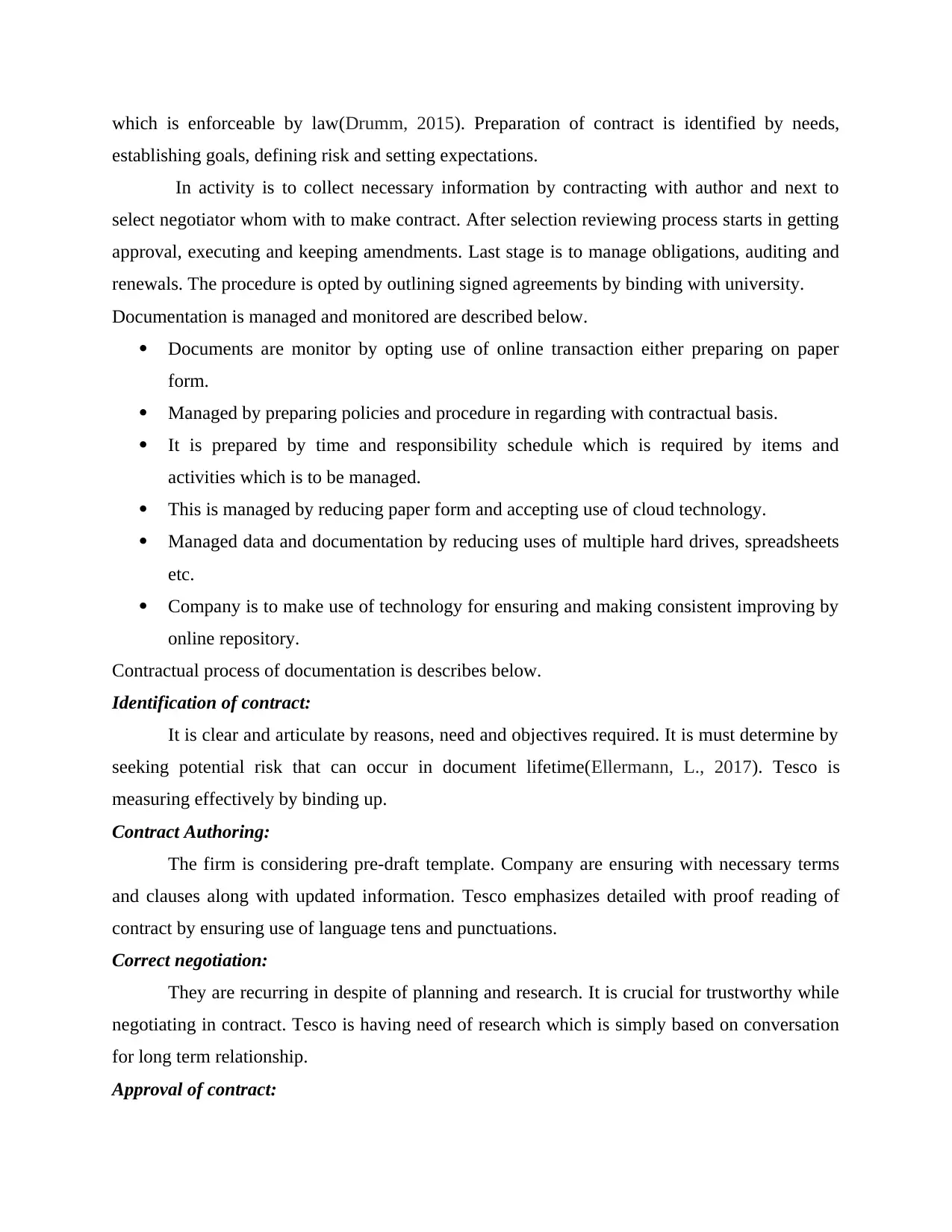
which is enforceable by law(Drumm, 2015). Preparation of contract is identified by needs,
establishing goals, defining risk and setting expectations.
In activity is to collect necessary information by contracting with author and next to
select negotiator whom with to make contract. After selection reviewing process starts in getting
approval, executing and keeping amendments. Last stage is to manage obligations, auditing and
renewals. The procedure is opted by outlining signed agreements by binding with university.
Documentation is managed and monitored are described below.
Documents are monitor by opting use of online transaction either preparing on paper
form.
Managed by preparing policies and procedure in regarding with contractual basis.
It is prepared by time and responsibility schedule which is required by items and
activities which is to be managed.
This is managed by reducing paper form and accepting use of cloud technology.
Managed data and documentation by reducing uses of multiple hard drives, spreadsheets
etc.
Company is to make use of technology for ensuring and making consistent improving by
online repository.
Contractual process of documentation is describes below.
Identification of contract:
It is clear and articulate by reasons, need and objectives required. It is must determine by
seeking potential risk that can occur in document lifetime(Ellermann, L., 2017). Tesco is
measuring effectively by binding up.
Contract Authoring:
The firm is considering pre-draft template. Company are ensuring with necessary terms
and clauses along with updated information. Tesco emphasizes detailed with proof reading of
contract by ensuring use of language tens and punctuations.
Correct negotiation:
They are recurring in despite of planning and research. It is crucial for trustworthy while
negotiating in contract. Tesco is having need of research which is simply based on conversation
for long term relationship.
Approval of contract:
establishing goals, defining risk and setting expectations.
In activity is to collect necessary information by contracting with author and next to
select negotiator whom with to make contract. After selection reviewing process starts in getting
approval, executing and keeping amendments. Last stage is to manage obligations, auditing and
renewals. The procedure is opted by outlining signed agreements by binding with university.
Documentation is managed and monitored are described below.
Documents are monitor by opting use of online transaction either preparing on paper
form.
Managed by preparing policies and procedure in regarding with contractual basis.
It is prepared by time and responsibility schedule which is required by items and
activities which is to be managed.
This is managed by reducing paper form and accepting use of cloud technology.
Managed data and documentation by reducing uses of multiple hard drives, spreadsheets
etc.
Company is to make use of technology for ensuring and making consistent improving by
online repository.
Contractual process of documentation is describes below.
Identification of contract:
It is clear and articulate by reasons, need and objectives required. It is must determine by
seeking potential risk that can occur in document lifetime(Ellermann, L., 2017). Tesco is
measuring effectively by binding up.
Contract Authoring:
The firm is considering pre-draft template. Company are ensuring with necessary terms
and clauses along with updated information. Tesco emphasizes detailed with proof reading of
contract by ensuring use of language tens and punctuations.
Correct negotiation:
They are recurring in despite of planning and research. It is crucial for trustworthy while
negotiating in contract. Tesco is having need of research which is simply based on conversation
for long term relationship.
Approval of contract:
⊘ This is a preview!⊘
Do you want full access?
Subscribe today to unlock all pages.

Trusted by 1+ million students worldwide
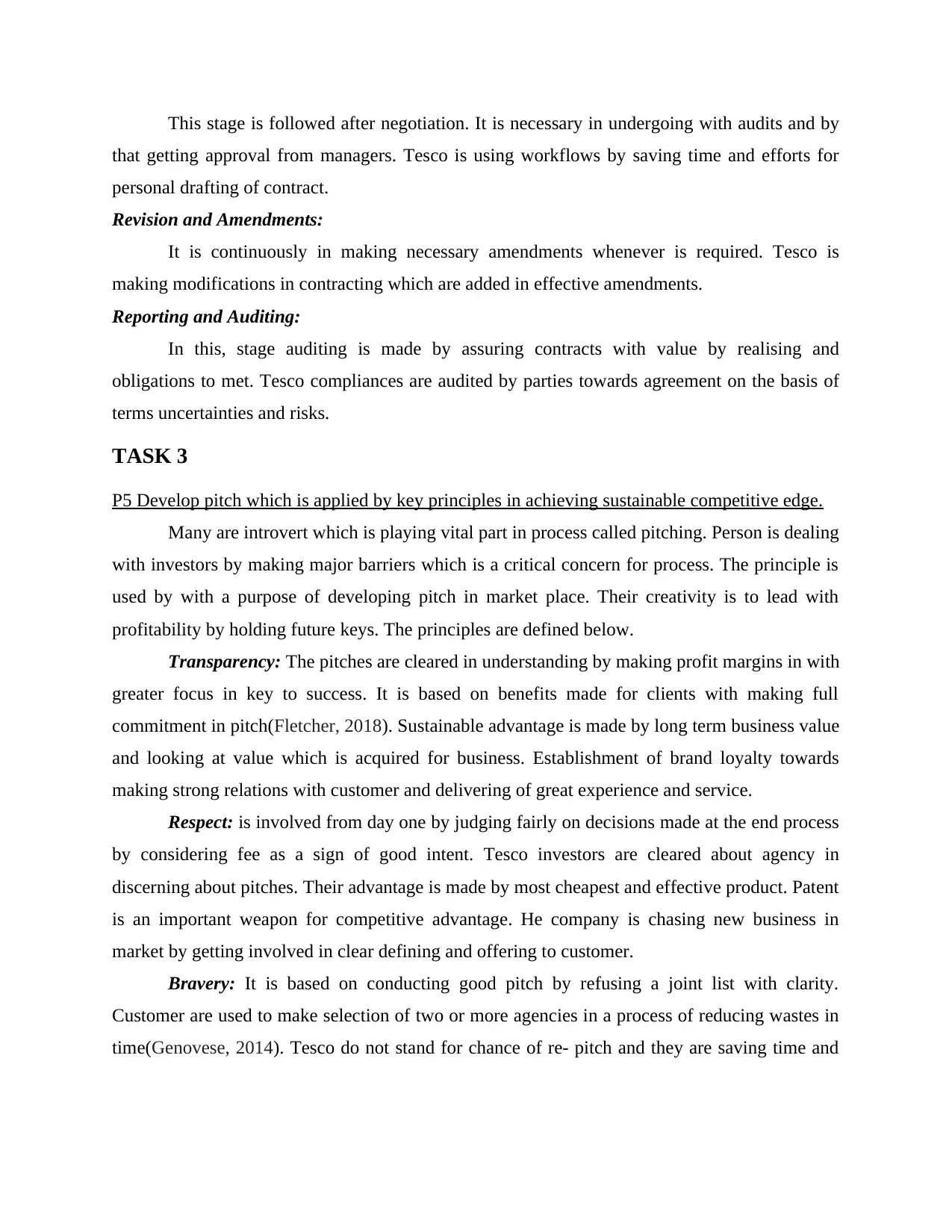
This stage is followed after negotiation. It is necessary in undergoing with audits and by
that getting approval from managers. Tesco is using workflows by saving time and efforts for
personal drafting of contract.
Revision and Amendments:
It is continuously in making necessary amendments whenever is required. Tesco is
making modifications in contracting which are added in effective amendments.
Reporting and Auditing:
In this, stage auditing is made by assuring contracts with value by realising and
obligations to met. Tesco compliances are audited by parties towards agreement on the basis of
terms uncertainties and risks.
TASK 3
P5 Develop pitch which is applied by key principles in achieving sustainable competitive edge.
Many are introvert which is playing vital part in process called pitching. Person is dealing
with investors by making major barriers which is a critical concern for process. The principle is
used by with a purpose of developing pitch in market place. Their creativity is to lead with
profitability by holding future keys. The principles are defined below.
Transparency: The pitches are cleared in understanding by making profit margins in with
greater focus in key to success. It is based on benefits made for clients with making full
commitment in pitch(Fletcher, 2018). Sustainable advantage is made by long term business value
and looking at value which is acquired for business. Establishment of brand loyalty towards
making strong relations with customer and delivering of great experience and service.
Respect: is involved from day one by judging fairly on decisions made at the end process
by considering fee as a sign of good intent. Tesco investors are cleared about agency in
discerning about pitches. Their advantage is made by most cheapest and effective product. Patent
is an important weapon for competitive advantage. He company is chasing new business in
market by getting involved in clear defining and offering to customer.
Bravery: It is based on conducting good pitch by refusing a joint list with clarity.
Customer are used to make selection of two or more agencies in a process of reducing wastes in
time(Genovese, 2014). Tesco do not stand for chance of re- pitch and they are saving time and
that getting approval from managers. Tesco is using workflows by saving time and efforts for
personal drafting of contract.
Revision and Amendments:
It is continuously in making necessary amendments whenever is required. Tesco is
making modifications in contracting which are added in effective amendments.
Reporting and Auditing:
In this, stage auditing is made by assuring contracts with value by realising and
obligations to met. Tesco compliances are audited by parties towards agreement on the basis of
terms uncertainties and risks.
TASK 3
P5 Develop pitch which is applied by key principles in achieving sustainable competitive edge.
Many are introvert which is playing vital part in process called pitching. Person is dealing
with investors by making major barriers which is a critical concern for process. The principle is
used by with a purpose of developing pitch in market place. Their creativity is to lead with
profitability by holding future keys. The principles are defined below.
Transparency: The pitches are cleared in understanding by making profit margins in with
greater focus in key to success. It is based on benefits made for clients with making full
commitment in pitch(Fletcher, 2018). Sustainable advantage is made by long term business value
and looking at value which is acquired for business. Establishment of brand loyalty towards
making strong relations with customer and delivering of great experience and service.
Respect: is involved from day one by judging fairly on decisions made at the end process
by considering fee as a sign of good intent. Tesco investors are cleared about agency in
discerning about pitches. Their advantage is made by most cheapest and effective product. Patent
is an important weapon for competitive advantage. He company is chasing new business in
market by getting involved in clear defining and offering to customer.
Bravery: It is based on conducting good pitch by refusing a joint list with clarity.
Customer are used to make selection of two or more agencies in a process of reducing wastes in
time(Genovese, 2014). Tesco do not stand for chance of re- pitch and they are saving time and
Paraphrase This Document
Need a fresh take? Get an instant paraphrase of this document with our AI Paraphraser
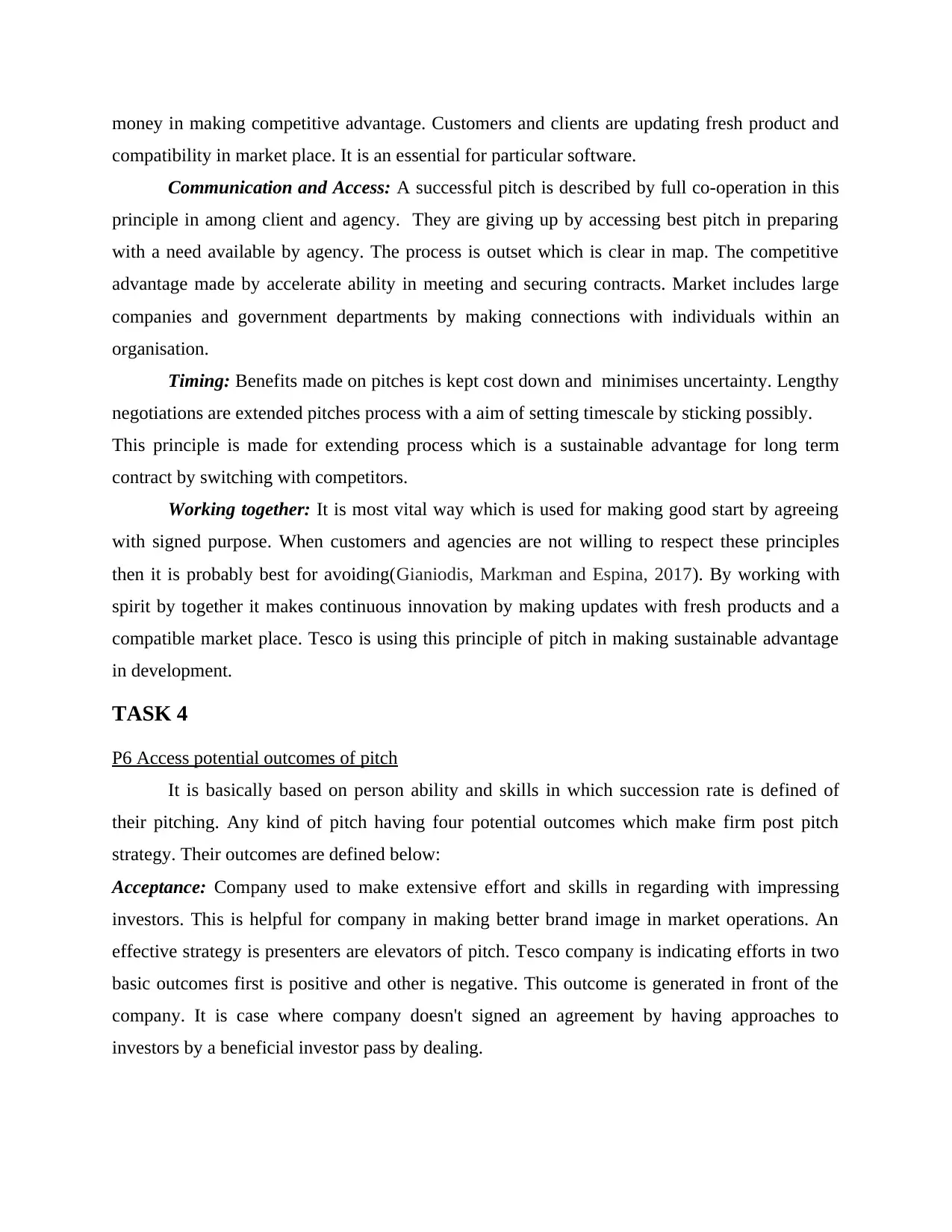
money in making competitive advantage. Customers and clients are updating fresh product and
compatibility in market place. It is an essential for particular software.
Communication and Access: A successful pitch is described by full co-operation in this
principle in among client and agency. They are giving up by accessing best pitch in preparing
with a need available by agency. The process is outset which is clear in map. The competitive
advantage made by accelerate ability in meeting and securing contracts. Market includes large
companies and government departments by making connections with individuals within an
organisation.
Timing: Benefits made on pitches is kept cost down and minimises uncertainty. Lengthy
negotiations are extended pitches process with a aim of setting timescale by sticking possibly.
This principle is made for extending process which is a sustainable advantage for long term
contract by switching with competitors.
Working together: It is most vital way which is used for making good start by agreeing
with signed purpose. When customers and agencies are not willing to respect these principles
then it is probably best for avoiding(Gianiodis, Markman and Espina, 2017). By working with
spirit by together it makes continuous innovation by making updates with fresh products and a
compatible market place. Tesco is using this principle of pitch in making sustainable advantage
in development.
TASK 4
P6 Access potential outcomes of pitch
It is basically based on person ability and skills in which succession rate is defined of
their pitching. Any kind of pitch having four potential outcomes which make firm post pitch
strategy. Their outcomes are defined below:
Acceptance: Company used to make extensive effort and skills in regarding with impressing
investors. This is helpful for company in making better brand image in market operations. An
effective strategy is presenters are elevators of pitch. Tesco company is indicating efforts in two
basic outcomes first is positive and other is negative. This outcome is generated in front of the
company. It is case where company doesn't signed an agreement by having approaches to
investors by a beneficial investor pass by dealing.
compatibility in market place. It is an essential for particular software.
Communication and Access: A successful pitch is described by full co-operation in this
principle in among client and agency. They are giving up by accessing best pitch in preparing
with a need available by agency. The process is outset which is clear in map. The competitive
advantage made by accelerate ability in meeting and securing contracts. Market includes large
companies and government departments by making connections with individuals within an
organisation.
Timing: Benefits made on pitches is kept cost down and minimises uncertainty. Lengthy
negotiations are extended pitches process with a aim of setting timescale by sticking possibly.
This principle is made for extending process which is a sustainable advantage for long term
contract by switching with competitors.
Working together: It is most vital way which is used for making good start by agreeing
with signed purpose. When customers and agencies are not willing to respect these principles
then it is probably best for avoiding(Gianiodis, Markman and Espina, 2017). By working with
spirit by together it makes continuous innovation by making updates with fresh products and a
compatible market place. Tesco is using this principle of pitch in making sustainable advantage
in development.
TASK 4
P6 Access potential outcomes of pitch
It is basically based on person ability and skills in which succession rate is defined of
their pitching. Any kind of pitch having four potential outcomes which make firm post pitch
strategy. Their outcomes are defined below:
Acceptance: Company used to make extensive effort and skills in regarding with impressing
investors. This is helpful for company in making better brand image in market operations. An
effective strategy is presenters are elevators of pitch. Tesco company is indicating efforts in two
basic outcomes first is positive and other is negative. This outcome is generated in front of the
company. It is case where company doesn't signed an agreement by having approaches to
investors by a beneficial investor pass by dealing.
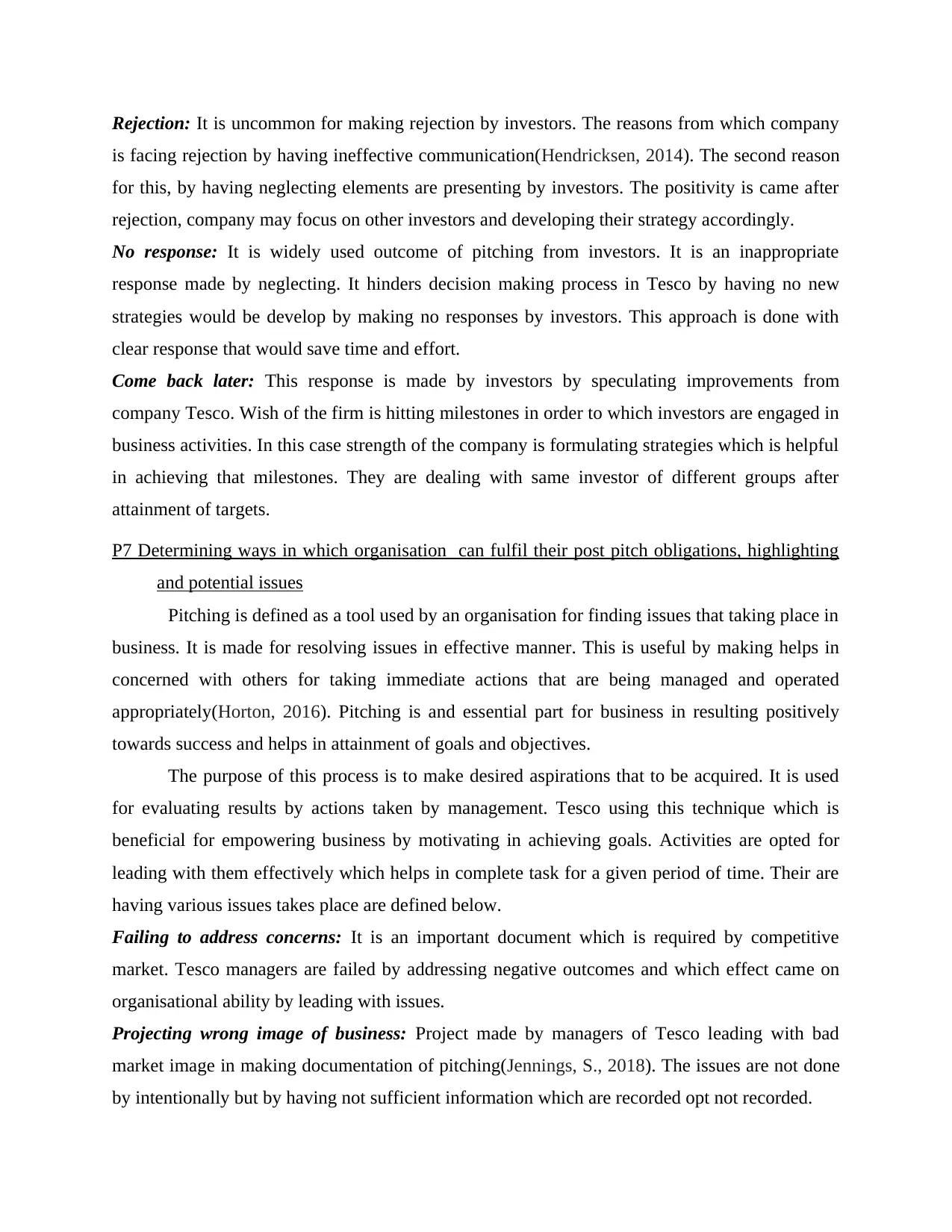
Rejection: It is uncommon for making rejection by investors. The reasons from which company
is facing rejection by having ineffective communication(Hendricksen, 2014). The second reason
for this, by having neglecting elements are presenting by investors. The positivity is came after
rejection, company may focus on other investors and developing their strategy accordingly.
No response: It is widely used outcome of pitching from investors. It is an inappropriate
response made by neglecting. It hinders decision making process in Tesco by having no new
strategies would be develop by making no responses by investors. This approach is done with
clear response that would save time and effort.
Come back later: This response is made by investors by speculating improvements from
company Tesco. Wish of the firm is hitting milestones in order to which investors are engaged in
business activities. In this case strength of the company is formulating strategies which is helpful
in achieving that milestones. They are dealing with same investor of different groups after
attainment of targets.
P7 Determining ways in which organisation can fulfil their post pitch obligations, highlighting
and potential issues
Pitching is defined as a tool used by an organisation for finding issues that taking place in
business. It is made for resolving issues in effective manner. This is useful by making helps in
concerned with others for taking immediate actions that are being managed and operated
appropriately(Horton, 2016). Pitching is and essential part for business in resulting positively
towards success and helps in attainment of goals and objectives.
The purpose of this process is to make desired aspirations that to be acquired. It is used
for evaluating results by actions taken by management. Tesco using this technique which is
beneficial for empowering business by motivating in achieving goals. Activities are opted for
leading with them effectively which helps in complete task for a given period of time. Their are
having various issues takes place are defined below.
Failing to address concerns: It is an important document which is required by competitive
market. Tesco managers are failed by addressing negative outcomes and which effect came on
organisational ability by leading with issues.
Projecting wrong image of business: Project made by managers of Tesco leading with bad
market image in making documentation of pitching(Jennings, S., 2018). The issues are not done
by intentionally but by having not sufficient information which are recorded opt not recorded.
is facing rejection by having ineffective communication(Hendricksen, 2014). The second reason
for this, by having neglecting elements are presenting by investors. The positivity is came after
rejection, company may focus on other investors and developing their strategy accordingly.
No response: It is widely used outcome of pitching from investors. It is an inappropriate
response made by neglecting. It hinders decision making process in Tesco by having no new
strategies would be develop by making no responses by investors. This approach is done with
clear response that would save time and effort.
Come back later: This response is made by investors by speculating improvements from
company Tesco. Wish of the firm is hitting milestones in order to which investors are engaged in
business activities. In this case strength of the company is formulating strategies which is helpful
in achieving that milestones. They are dealing with same investor of different groups after
attainment of targets.
P7 Determining ways in which organisation can fulfil their post pitch obligations, highlighting
and potential issues
Pitching is defined as a tool used by an organisation for finding issues that taking place in
business. It is made for resolving issues in effective manner. This is useful by making helps in
concerned with others for taking immediate actions that are being managed and operated
appropriately(Horton, 2016). Pitching is and essential part for business in resulting positively
towards success and helps in attainment of goals and objectives.
The purpose of this process is to make desired aspirations that to be acquired. It is used
for evaluating results by actions taken by management. Tesco using this technique which is
beneficial for empowering business by motivating in achieving goals. Activities are opted for
leading with them effectively which helps in complete task for a given period of time. Their are
having various issues takes place are defined below.
Failing to address concerns: It is an important document which is required by competitive
market. Tesco managers are failed by addressing negative outcomes and which effect came on
organisational ability by leading with issues.
Projecting wrong image of business: Project made by managers of Tesco leading with bad
market image in making documentation of pitching(Jennings, S., 2018). The issues are not done
by intentionally but by having not sufficient information which are recorded opt not recorded.
⊘ This is a preview!⊘
Do you want full access?
Subscribe today to unlock all pages.

Trusted by 1+ million students worldwide
1 out of 15
Related Documents
Your All-in-One AI-Powered Toolkit for Academic Success.
+13062052269
info@desklib.com
Available 24*7 on WhatsApp / Email
![[object Object]](/_next/static/media/star-bottom.7253800d.svg)
Unlock your academic potential
Copyright © 2020–2025 A2Z Services. All Rights Reserved. Developed and managed by ZUCOL.




